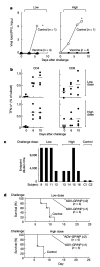Accelerated vaccination for Ebola virus haemorrhagic fever in non-human primates
- PMID: 12904795
- PMCID: PMC7095492
- DOI: 10.1038/nature01876
Accelerated vaccination for Ebola virus haemorrhagic fever in non-human primates
Abstract
Containment of highly lethal Ebola virus outbreaks poses a serious public health challenge. Although an experimental vaccine has successfully protected non-human primates against disease, more than six months was required to complete the immunizations, making it impractical to limit an acute epidemic. Here, we report the development of accelerated vaccination against Ebola virus in non-human primates. The antibody response to immunization with an adenoviral (ADV) vector encoding the Ebola glycoprotein (GP) was induced more rapidly than with DNA priming and ADV boosting, but it was of lower magnitude. To determine whether this earlier immune response could nonetheless protect against disease, cynomolgus macaques were challenged with Ebola virus after vaccination with ADV-GP and nucleoprotein (NP) vectors. Protection was highly effective and correlated with the generation of Ebola-specific CD8(+) T-cell and antibody responses. Even when animals were immunized once with ADV-GP/NP and challenged 28 days later, they remained resistant to challenge with either low or high doses of virus. This accelerated vaccine provides an intervention that may help to limit the epidemic spread of Ebola, and is applicable to other viruses.
Conflict of interest statement
The authors declare that they have no competing financial interests.
Figures




Comment in
-
Fast vaccine offers hope in battle with Ebola.Nature. 2003 Aug 7;424(6949):602. doi: 10.1038/424602a. Nature. 2003. PMID: 12904747 Free PMC article. No abstract available.
References
MeSH terms
Substances
LinkOut - more resources
Full Text Sources
Other Literature Sources
Medical
Research Materials
Miscellaneous

